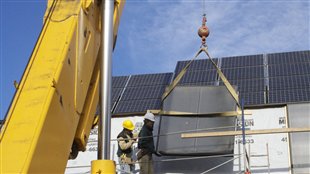Nuclear electricity generating plants are ageing in the province of Ontario and its government should look at green alternatives to building new reactors, say Greenpeace and the think-tank, the Pembina Institute. Ontario’s current strategy commits to generating half the province’s electricity with nuclear and that should change according to a report entitled Renewable is Doable.
“There has been a tendency to over predict energy or electricity demand,” says Tim Weis, director of renewable energy and efficiency police with the Pembina Institute. “What that’s meant is that there’s been an emphasis, particularly in Ontario, on building new nuclear plants to meet that demand.”
Forecasts of increased energy demand have tended to not come true over the last 20 to 30 years, says Weis. So he does not think it is time to build a new nuclear reactor.
Nuclear costly, inflexible says report
While nuclear energy does not emit the greenhouse gases that coal and gas burning do, he says it is not flexible and does not respond to fluctuations in demand. He adds that no nuclear reactor has ever been built on time or on budget in Ontario. Such projects have from 40 to 200 per cent more than original estimates.
Instead Weis thinks it’s time to build a suite of alternative energy systems based on wind, solar, water, and biomass. They could be built in increments to answer Ontario’s changing electricity needs and could take advantage of decreasing costs for renewable energy systems.

Ontario has been a leader in developing wind and solar energy in Canada, says Weis. He adds that Canada is in the top ten in terms of wind generation installed and in the top three when it comes to water generation installed. But he says there are still a lot of coal-fired plants in Canada.
“The big thing that we’re recommending,” says Weis, “is…let’s put the full costs on the table and make sure we’re not diving into a new nuclear facility that we don’t need at this stage of the game.
“And, as these older plants near the end of their lives let’s compare them to what other alternatives are out there …to make sure that we’re making the most cost-effective, low-carbon alternative going forward.”







For reasons beyond our control, and for an undetermined period of time, our comment section is now closed. However, our social networks remain open to your contributions.